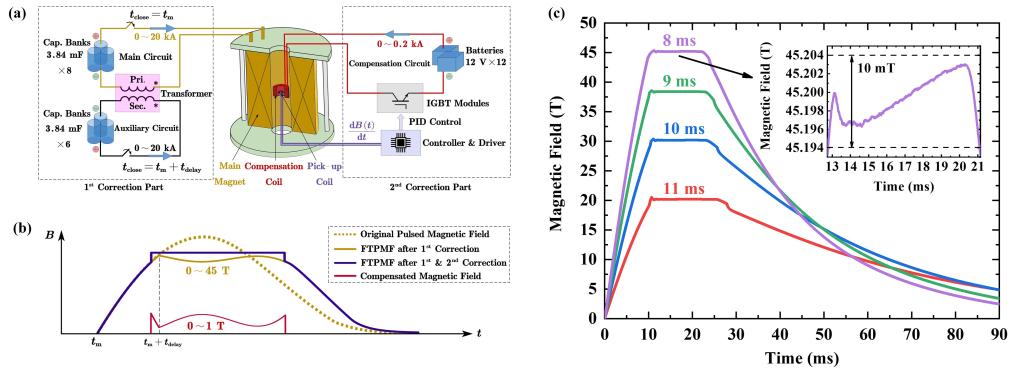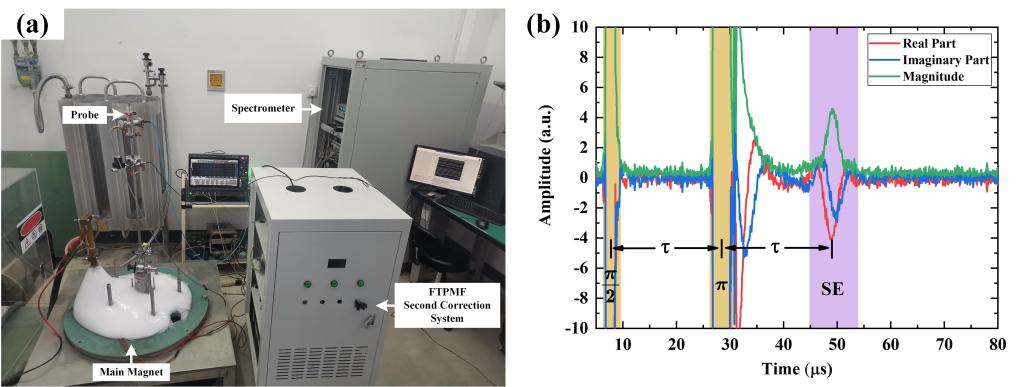On April 20th, the authoritative international journal in the field of instruments and measurement, IEEE Transactions on Instrumentation and Measurement, published two research papers online in the field of nuclear magnetic resonance technology by the team of Professor Xiaotao Han from the Wuhan National High Magnetic Field Center. These two papers are titled "Nuclear Magnetic Resolution Measures in High Flat top Pulsed Magnetic Field up to 40 T at WHMFC" and "High Frequency Broadband RF Transmit Receive Switch for Pulsed Magnetic Field NMR". The Wuhan National High Magnetic Field Center is the first institute to complete the paper, with Professor Xiaotao Han as the corresponding author. Wenqi Wei, a doctoral student and Le Yuan, a master's student, are the first authors. The team of Professor Yongkang Luo assisted in the design of probes and scientific experiments.
The high magnetic field is an important extreme experimental condition that supports basic research in fields such as physics, chemistry, and materials. It can affect the electronic and quantum states of matter, thereby detecting the field-induced properties of special systems. The higher the magnetic field strength, the greater the opportunity for scientific discovery. At present, the maximum magnetic field strength that can be achieved by non-destructive pulsed magnets internationally has reached 100 Tesla (T). However, due to its inherent time-varying and transient characteristics, it is difficult to carry out high-precision measurement experiments in pulsed magnetic field such as nuclear magnetic resonance (NMR), specific heat, and I-V curves that require stable and sustained magnetic field for a certain period of time. Hence, it is urgent to develop new high magnetic field technologies. The flat-top pulsed magnetic field is a special time-varying magnetic field that combines the advantages of high magnetic field strength and high stability, making it possible to providing a new magnetic field environment for scientific research in high magnetic fields. Taking NMR as an example, it has wide applications in various fields such as condensed matter physics, life sciences, and medical imaging, and is one of the main means of deriving detailed information on the atomic scale about material properties. The pulsed high magnetic field nuclear magnetic resonance (PMF-NMR) technology has the ability to regulate the physical properties of materials and detect samples at the atomic level, which is expected to bring new opportunities for discovering new phenomena, proposing new principles, and synthesizing new materials. However, existing PMF-NMR measurements are carried out under time-varying magnetic fields, and there are difficulties in accurately exciting resonance, correcting distorted NMR signals, and achieving high-field and high-frequency applications.
In this background, the team of Professor Xiaotao Han further developed the flat-top pulsed magnetic field technology based on experimental devices from the Wuhan National High Magnetic Field Center. They took the lead in proposing the flat-top pulsed magnetic field nuclear magnetic resonance spectrometer scheme (FTPMF-NMR) internationally, invented the "field-circuit coupling and linear feedback" magnetic field regulation method, solved the problem of waveform regulation with high stability in pulsed high magnetic fields, and successfully achieved the magnetic field with a peak strength of 45.199 T, a duration of 8 ms and a fluctuation of ± 5 mT (stability of about 110 ppm) in the flat-top interval (Figure 1). The team independently developed key RF components and layered control interaction programs for the NMR spectrometer, achieving a high-frequency broadband modular NMR spectrometer with a receiving/transmitting frequency of 1 GHz, real-time bandwidth of 20 MHz, and dual-end isolation of 100 dB. On this basis, the team established a corresponding experimental platform and achieved NMR signal measurements of 93Nb nuclei in the 40-T flat-top magnetic field (Figure 2), laying a solid foundation for NMR scientific measurement in ultra-high pulsed magnetic fields. The FTPMF-NMR technology will provide new opportunities for cutting-edge scientific research under high magnetic fields, such as high-temperature superconducting mechanisms, quantum critical points of heavy fermion materials, ground states and phase transitions of quantum spin systems, which is of great significance for solving major scientific problems in related fields.
This research work has been supported by projects such as the National Key R&D Program, the National Natural Science Foundation of China, and the Interdisciplinary Program of Wuhan National High Magnetic Field Center.
In recent years, relying on the experimental devices from the Wuhan National High Magnetic Field Center, Professor Xiaotao Han has led a team to actively devote themselves to the research of flat-top pulsed magnetic field regulation technology and related scientific experimental systems. They have achieved flat-top pulsed magnetic fields of 23.370T/100ms/64ppm, 45.199T/8ms/110ppm, and built physical property measurement systems such as NMR and I-V characteristics in flat-top pulsed magnetic fields, providing a unique experimental platform for relevant cutting-edge basic scientific research.

Figure 1 "field-circuit coupling and linear feedback" flat-top pulsed high magnetic field: (a) Schematic diagram of the system; (b) Schematic diagram of regulating waveform; (c) Actual measurement waveforms of the flat-top pulsed magnetic field.

Figure 2 (a) FTPMF-NMR scientific experimental platform; (b) NMR spin-echo signal of 93Nb nuclei measured in the flat-top pulsed magnetic field.
